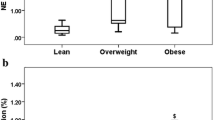Abstract
Obesity has become epidemic worldwide and is especially pronounced in women of reproductive age, which is important because obesity is a major risk factor for preeclampsia and chronic hypertension. We hypothesized that vascular inflammation is critical to the pathophysiology of hypertension in obese individuals because obesity and hypertensive disorders share common features related to inflammation. To study this, we collected subcutaneous fat biopsies from normal weight, overweight, and obese women and stained the tissues for CD66b, a neutrophil marker, and for activated nuclear factor-?B (NF-?B) and cyclooxygenase-2 (COX-2) as markers of inflammation. We found that the number of neutrophils per vessel and the percentage and intensity of vessel staining for CD66b, NF-?B and COX-2 were greatest in obese women and least in normal weight women, and that neutrophil infiltration and vascular inflammation significantly correlated with body mass index (BMI) and blood pressure. These data may help explain the relationship between obesity and hypertensive disorders.
Similar content being viewed by others
References
Flegal KM, Carroll MD, Ogden CL, Johnson CL. Prevalence and trends in obesity among US adults, 1999–2000. JAMA. 2002;288(14):1723–1727.
Mokdad AH, Ford ES, Bowman BA, et al. Prevalence of obesity, diabetes, and obesity-related health risk factors, 2001. JAMA. 2003;289(1):76–79.
Srinivasan SR, Myers L, Berenson GS. Changes in metabolic syndrome variables since childhood in prehypertensive and hypertensive subjects: the Bogalusa Heart Study. Hypertension. 2006;48(1):33–39.
Thomas F, Bean K, Pannier B, Oppert JM, Guize L, Benetos A. Cardiovascular mortality in overweight subjects: the key role of associated risk factors. Hypertension. 2005;46(4):654–659.
Bodnar LM, Ness RB, Markovic N, Roberts JM. The risk of preeclampsia rises with increasing prepregnancy body mass index. Ann Epidemiol. 2005;15(7):475–482.
O’Brien TE, Ray JG, Chan WS. Maternal body mass index and the risk of preeclampsia: a systematic overview. Epidemiology. 2003;14(3):368–374.
Hansel B, Giral P, Nobecourt E, et al. Metabolic syndrome is associated with elevated oxidative stress and dysfunctional dense high-density lipoprotein particles displaying impaired antioxidative activity. J Clin Endocrinol Metab. 2004;89(10):4963–4971.
Keaney JF Jr. Larson MG, Vasan RS, et al. Obesity and systemic oxidative stress: clinical correlates of oxidative stress in the Framingham Study. Arterioscler Thromb Vasc Biol. 2003;23(3):434–439.
Bray GA. Medical consequences of obesity. J Clin Endocrinol Metab. 2004;89(6):2583–2589.
Esposito K, Nicoletti G, Giugliano D. Obesity, cytokines and endothelial dysfunction: a link for the raised cardiovascular risk associated with visceral obesity. J Endocrinol Invest. 2002;25(7):646–649.
Straczkowski M, Dzienis-Straczkowska S, Stepien A, Kowalska I, Szelachowska M, Kinalska I. Plasma interleukin-8 concentrations are increased in obese subjects and related to fat mass and tumor necrosis factor-alpha system. J Clin Endocrinol Metab. 2002;87(10):4602–4606.
Zhou L, Xiang W, Potts J, et al. Reduction in extracellular super-oxide dismutase activity in African-American patients with hypertension. Free Radic Biol Med. 2006;41(9):1384–1391.
Touyz RM. Reactive oxygen species, vascular oxidative stress, and redox signaling in hypertension: what is the clinical significance? Hypertension. 2004;44(3):248–252.
Walsh SW. Maternal-placental interactions of oxidative stress and antioxidants in preeclampsia. Semin Reprod Endocrinol. 1998;16(1):93–104.
Walsh SW, Vaughan JE, Wang Y, Roberts LJ II. Placental isoprostane is significantly increased in preeclampsia. FASEB J. 2000;14(10):1289–1296.
Pitsavos C, Chrysohoou C, Panagiotakos DB, Lentzas Y, Stefanadis C. Abdominal obesity and inflammation predicts hypertension among prehypertensive men and women: the ATTICA Study. Heart Vessels. 2008;23(2):96–103.
Bautista LE, Vera LM, Arenas IA, Gamarra G. Independent association between inflammatory markers (C-reactive protein, interleukin-6, and TNF-alpha) and essential hypertension. J Hum Hypertens. 2005;19(2):149–154.
Kupferminc MJ, Peaceman AM, Aderka D, Wallach D, Socol ML. Soluble tumor necrosis factor receptors and interleukin-6 levels in patients with severe preeclampsia. Obstet Gynecol. 1996;88(3):420–427.
Qiu C, Luthy DA, Zhang C, Walsh SW, Leisenring WM, Williams MA. A prospective study of maternal serum C-reactive protein concentrations and risk of preeclampsia. Am J Hypertens. 2004;17(2):154–160.
Ferrannini E, Balkau B, Coppack SW, et al. Insulin resistance, insulin response, and obesity as indicators of metabolic risk. J Clin Endocrinol Metab. 2007;92(8):2885–2892.
Freeman DJ, McManus F, Brown EA, et al. Short- and long-term changes in plasma inflammatory markers associated with preeclampsia. Hypertension. 2004;44(5):708–714.
Kaaja R. Insulin resistance syndrome in preeclampsia. Semin Reprod Endocrinol. 1998;16(1):41–46.
Mishra NV, Walsh SW. Reactive oxygen species enhance vascular reactivity to angiotensin II via the rho A kinase pathway. Reprod Sci. 2009;16(suppl):71A.
Uehata M, Ishizaki T, Satoh H, et al. Calcium sensitization of smooth muscle mediated by a Rho-associated protein kinase in hypertension. Nature. 1997;389(6654):990–994.
Asano M, Nomura Y. Comparison of inhibitory effects of Y-27632, a Rho kinase inhibitor, in strips of small and large mesenteric arteries from spontaneously hypertensive and normotensive Wistar-Kyoto rats. Hypertens Res. 2003; 26(1):97–106.
Eiserich JP, Baldus S, Brennan ML, et al. Myeloperoxidase, a leukocyte-derived vascular NO oxidase. Science. 2002; 296(5577):2391–2394.
Leik CE, Walsh SW. Neutrophils infiltrate resistance-sized vessels of subcutaneous fat in women with preeclampsia. Hypertension. 2004;44(1):72–77.
Shah TJ, Walsh SW. Activation of NF-kappaB and expression of COX-2 in association with neutrophil infiltration in systemic vascular tissue of women with preeclampsia. Am J Obstet Gynecol. 2007;196(1):48.e41–48.e48.
Author information
Authors and Affiliations
Corresponding author
Additional information
Presented at the 53rd Annual Meeting of the Society for Gynecologic Investigation, March 22–25, 2006, Toronto, Canada.
Rights and permissions
About this article
Cite this article
Shah, T.J., Leik, C.E. & Walsh, S.W. Neutrophil Infiltration and Systemic Vascular Inflammation in Obese Women. Reprod. Sci. 17, 116–124 (2010). https://doi.org/10.1177/1933719109348252
Published:
Issue Date:
DOI: https://doi.org/10.1177/1933719109348252




